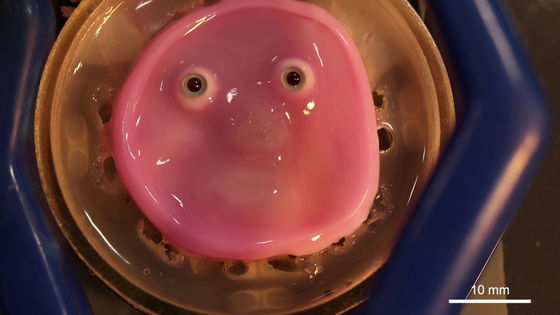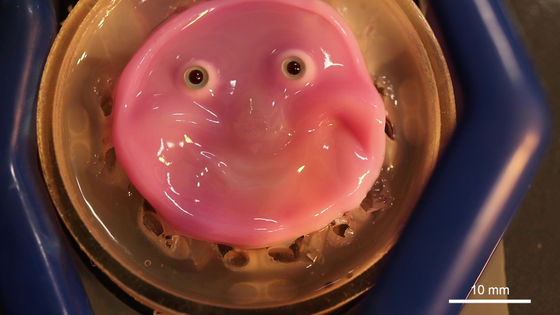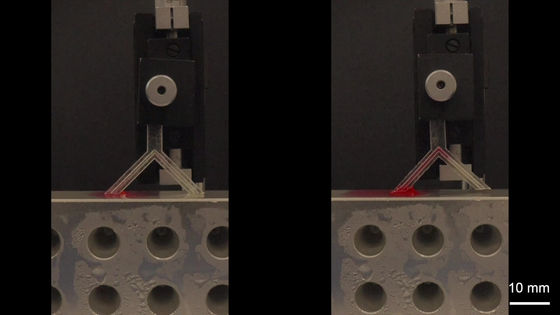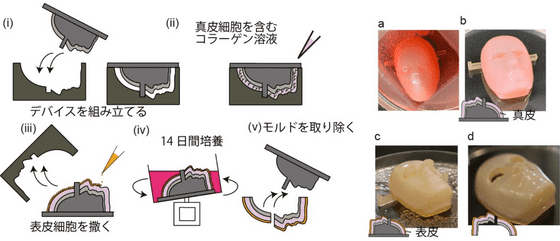University of Tokyo research group develops robot with 'living skin' cultured from human cells

by
A research group from the University of Tokyo and Harvard University has developed a 'face-shaped robot with living skin' made from cultured human skin. Just as human skin does not slip or slip with the flesh underneath, the technology to firmly attach biological tissue to the surface of the robot is expected to be applied to soft robots with natural flexibility and self-repairing capabilities, as well as in the cosmetics and cosmetic surgery industries.
Perforation-type anchors inspired by skin ligament for robotic face covered with living skin: Cell Reports Physical Science
https://www.cell.com/cell-reports-physical-science/fulltext/S2666-3864(24)00335-7
Robot face with living skin | University of Tokyo
https://www.u-tokyo.ac.jp/focus/ja/press/z0114_00046.html
Robots face the future | EurekAlert!
https://www.eurekalert.org/news-releases/1049030?
You can see the face of a robot with living skin, developed by a research group at the University of Tokyo, in the video below.
A movie in which a face-shaped robot with living skin smiles - YouTube
A sullen-faced robot.

The corners of his mouth turned up as he smiled, creating dimples on his cheeks.

Humanoid robots, which are expected to work and blend into society, have so far been given a human-like appearance by covering them with silicone. However, this material does not have the same sensing capabilities as human skin, such as the ability to release heat through sweat, or to self-repair.
Robots with living tissue are key to solving these problems: a group from the University of Tokyo has previously developed a finger-shaped robot with living skin that can repair itself.

Professor Masaharu Takeuchi of the University of Tokyo, who was researching finger-type robots, said he felt that it was necessary to 'improve the adhesion between the robot and the subcutaneous structure of the skin.' However, conventional anchors used to attach biological tissue to artificial objects have the drawback that the anchors protruding from the skin interfere with the appearance and movement of the robot.
The research group was inspired by the collagen fibers called 'retinaculum' that secure human skin to subcutaneous tissue, and developed a 'hole-type anchor structure' in which V-shaped holes are drilled into the surface of the robot and collagen gel is injected into the holes to attach the skin to the robot.

It is extremely difficult to inject a viscous collagen gel into tiny holes, but the research group was able to incorporate collagen into the microstructure by using a technique called plasma treatment , which is used for bonding plastics, to make the material hydrophilic.
The following images show the effectiveness of plasma treatment. The untreated V-shaped structure on the left is barely permeated with collagen solution, while the plasma-treated V-shaped structure on the right is able to inject the solution without introducing any air bubbles.

The research group succeeded in creating a facial structure covered with living cultured skin.

As a demonstration, we also developed a face-shaped robot that smiles by transmitting motor movement to the skin through hole-shaped anchors.

This technology could be useful in skin aging research, as well as in cosmetics, surgery and plastic surgery research, and embedding sensors in the skin could also lead to better sensing and interactive robots.
Professor Takeuchi said, 'In this research, we were able to create a face with the same surface material and structure as a human's, but we also found that there are challenges such as the need for wrinkles and thickness to give it a more human-like appearance. It is also important to create human-like facial expressions by incorporating sophisticated actuators, or muscles, within the robot. It is a worthwhile challenge to create a robot that has self-healing capabilities, can sense its environment more accurately, and can perform tasks with human-like dexterity.'
◆ Forum is currently open
A forum related to this article has been set up on the official GIGAZINE Discord server . Anyone can post freely, so please feel free to comment! If you do not have a Discord account, please refer to the account creation procedure article to create an account!
• Discord | 'Which is better for the exterior of a humanoid robot: 'human-like skin' or 'robot-like texture?' | GIGAZINE
https://discord.com/channels/1037961069903216680/1255451333688037446
Related Posts:






